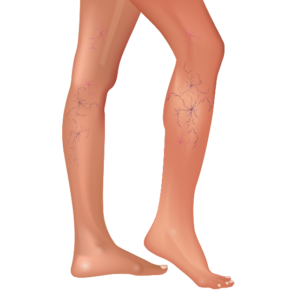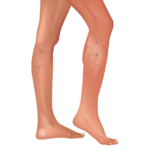 We were amazed to find just how much misinformation is floating around out there on the world wide web. No wonder everyone is so confused. Allow us to clarify.
We were amazed to find just how much misinformation is floating around out there on the world wide web. No wonder everyone is so confused. Allow us to clarify.
Myth #1: Only overweight people get spider veins.
While weight may be a risk factor for developing spider veins, being overweight alone does not guarantee that you’ll develop them. They’re more often the result of genetics, hormone changes, aging, and other factors.
Myth #2: You can only get spider veins on your legs.
Totally false. While they’re more common on the legs and ankles, spider veins can also develop on your face. Spider veins appear as tiny wiggly lines of red, blue, or purple blood vessels. Individuals with fair skin who don’t take steps to protect themselves from the sun’s harmful ultra-violet rays can develop spider veins on their cheeks.
Myth #3: Topical creams that contain high doses of Vitamin K can help reduce the appearance of spider veins.
It’s true that without Vitamin K, our blood would have trouble coagulating and uncontrolled bleeding could occur. Vitamin K is also an important nutrient for heart health. But while Vitamin K has been used over the years to treat bruising and to reduce rosacea, there’s no scientific evidence to suggest that it improves vein health when applied topically.
Myth #4: Drinking ginger tea with honey or diluted cayenne pepper in hot water are two natural, effective treatments for getting rid of spider veins.
Some home remedy or homeopathic websites suggest that ginger can help improve circulation and dissolve proteins that build up in damaged veins. Others suggest cayenne pepper is rich in bioflavonoids, which can increase blood circulation and ease the pain associated with swollen veins. However, neither cure-all carries much weight, and there’s no scientific evidence to suggest that either alternative approach works.
Myth #5: “I don’t need to see a doctor for spider veins because they’re not like varicose veins. They’re just a sign of old age.”
When the skin above spider veins grows tender and warm to the touch, or when veins become painful or bleed, it’s time to see a vein specialist. Spider veins can be associated with other more-serious conditions, such as skin ulcers or phlebitis, the inflammation of a vein caused by a blood clot.
For more myths and half-truths about vein health check out the article five common myths about varicose veins as well as common spider vein myths.
Get the truth about varicose veins, spider veins, and treatment options from the trusted professionals at West Florida Vein Center, a division of Surgical Associates of West Florida. To request a consultation or for more information, visit www.westfloridaveincenter.com or call 727-712-3233.
